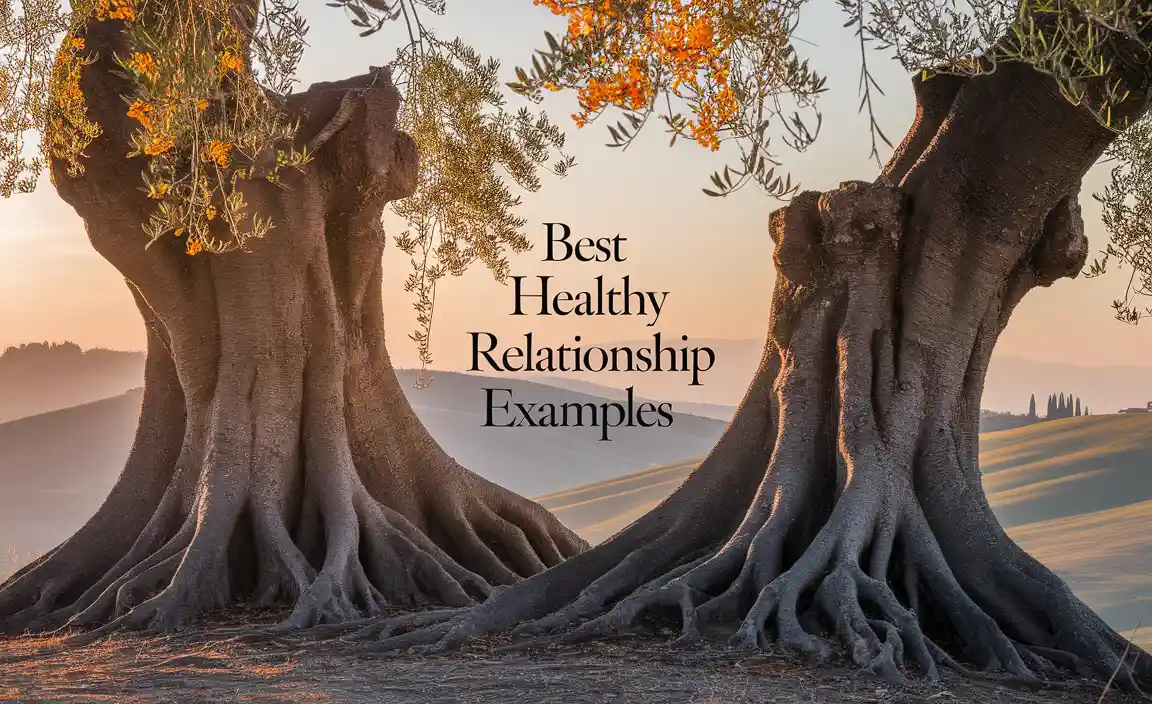Discover the best healthy relationship examples that show how strong connections thrive with clear communication, mutual respect, and shared joy. These proven vitality boosters will help you build and maintain fulfilling friendships and romantic partnerships.

Building strong, vibrant relationships isn’t always easy. Many of us wonder what truly makes a connection last and feel good. Do healthy relationships just happen, or is there a secret formula? It can be frustrating when we see others with what seem like effortless bonds, while ours feel like a struggle. But the good news is, healthy relationships are built on observable principles and consistent effort. You can cultivate deeper, more joyful connections. This guide will walk you through the key elements and provide clear examples to help you foster more vitality in your friendships and romantic partnerships.
What Are Healthy Relationship Examples?
At its core, a healthy relationship is one where both individuals feel safe, respected, valued, and genuinely supported. It’s a safe space for vulnerability and growth, where partners can be their authentic selves without fear of judgment or criticism. These relationships are characterized by open communication, mutual trust, shared responsibility, and a genuine desire for each other’s well-being. They feel energizing rather than draining, and they contribute positively to the lives of everyone involved.
Key Pillars of Healthy Relationships
To truly understand what makes a healthy relationship thrive, let’s break down the essential components. These aren’t just abstract ideas; they manifest in everyday interactions and choices.
- Open and Honest Communication: This means expressing your thoughts, feelings, and needs clearly and kindly, and actively listening when the other person speaks. It involves being able to discuss difficult topics without resorting to blame or defensiveness.
- Mutual Respect: Valuing each other’s opinions, boundaries, and individuality, even when you disagree. It’s about treating each other with consideration and acknowledging each other’s worth.
- Trust: Believing in your partner’s honesty, reliability, and good intentions. Trust is built over time through consistent actions and open communication.
- Support: Being there for each other through good times and bad. This includes celebrating successes, offering comfort during struggles, and encouraging each other’s personal growth.
- Shared Responsibility: Working together as a team to manage life’s challenges, chores, and decisions. This means both individuals contribute to the relationship’s upkeep and success.
- Individuality and Boundaries: Recognizing that each person is a unique individual with their own needs, interests, and friendships. Healthy relationships allow for personal space and autonomy.
- Conflict Resolution: The ability to navigate disagreements constructively, seeking solutions that work for both people rather than trying to “win” an argument.
- Affection and Appreciation: Regularly showing love, kindness, and gratitude. This can be through words, actions, or physical touch, depending on what feels natural to the individuals.
Proven Vitality Boosters: Real-Life Healthy Relationship Examples
Let’s move from theory to practice. What do these pillars look like in action? Here are some concrete examples that illustrate the vitality of healthy connections.
Example 1: The “Check-In” Ritual
A couple has a simple nightly ritual before bed. They dedicate five minutes to ask each other: “What was the highlight of your day?” and “What was a challenge you faced today?” This isn’t about solving problems unless explicitly asked, but about sharing experiences and offering a listening ear.
Why it works: This practice fosters open communication and mutual support. It allows partners to stay connected to each other’s daily lives,Big or small, and provides a gentle way to acknowledge both joy and difficulty, reinforcing that they are a team. It’s a simple act that builds intimacy and understanding.
Example 2: Respecting Boundaries During “Me Time”
Sarah loves her evenings to read and disconnect. Her partner, Mark, thrives on social interaction. Instead of feeling resentful when Sarah wants her quiet time, Mark understands and respects it. He might say, “Enjoy your reading, honey! I’m going to call my brother for a bit. Let me know when you’re ready for some company or if you want to chat later.”
Why it works: This showcases individuality and respect for boundaries. Mark doesn’t take Sarah’s need for solitude personally, and Sarah knows Mark has his own interests and social needs. This balance prevents codependency and ensures both individuals feel their personal space is valued. According to relationship expert Dr. John Gottman, respecting each other’s need for autonomy is crucial for long-term relationship health.
Example 3: Collaborative Decision-Making on Big Purchases
A young couple, Alex and Ben, are planning to buy a new couch. Instead of one person deciding, they sit down together. They discuss their budget, their style preferences, the size of their living room, and how they’ll use it. They research options online, visit a store to test them out, and make the final decision jointly.
Why it works: This demonstrates shared responsibility. It ensures both partners feel heard and that the decision reflects their collective needs and preferences. This collaborative approach extends to other areas, like managing finances, planning events, or even deciding on weekend activities, creating a sense of partnership.
Example 4: Expressing Appreciation Regularly
When Maria notices her friend, Chloe, always remembering to bring her favorite snack when they meet, she makes a point of saying, “Chloe, it means so much to me that you always remember how much I love these chips. It makes me feel really seen and cared for.” Chloe, in turn, might say to Maria, “I really appreciate how you always make time for our weekly calls, even when you’re so busy.”
Why it works: Regular expressions of appreciation strengthen the emotional bond. It reinforces positive behaviors and makes each person feel valued. This isn’t about grand gestures, but consistent, genuine acknowledgments of each other’s efforts and presence.
Example 5: Constructive Conflict Resolution (The “We” Not “You” Approach)
Imagine a misunderstanding arises. Instead of saying, “You always leave your socks on the floor!”, one partner might say, “I feel a bit overwhelmed when I see socks around the living room. Can we work on finding a better system for keeping them put away so our shared space feels tidier for both of us?”
Why it works: This shifts the focus from blame to collaboration. It uses “I” statements to express feelings without accusing the other person and frames the problem as something to be solved together. This approach, often called “constructive confrontation,” is vital for overcoming conflicts without damaging the relationship. Research from the American Psychological Association highlights the tools and strategies for healthy conflict resolution.
Example 6: Supporting Individual Passions and Growth
David is passionate about woodworking, which takes up a significant amount of his free time. His partner, Lisa, is pursuing a master’s degree and has demanding study hours. Instead of competing for time or resources, they actively support each other’s passions. Lisa helps David pack up his tools when he’s done for the day, and David makes sure Lisa has quiet study time, bringing her snacks and coffee.
Why it works: This example illustrates mutual support for personal growth and individuality. Both partners understand that pursuing personal interests enriches their lives and, in turn, enriches the relationship. They make allowances for each other’s commitments and actively facilitate them.
Example 7: Celebrating and Acknowledging Milestones
A group of friends has a tradition for birthdays and significant achievements. They don’t just send a text; they organize a small gathering, write heartfelt cards, or plan a special outing. When one friend lands a dream job, the others might plan a surprise celebratory dinner.
Why it works: This shows intentionality in celebrating each other. It demonstrates that the friends genuinely care about each other’s successes and want to acknowledge them in meaningful ways. This shared joy strengthens the bonds of friendship and creates lasting memories.
The Role of Vulnerability in Healthy Relationships
Vulnerability is often misunderstood. It’s not about oversharing or unloading all your problems on someone. In healthy relationships, vulnerability means having the courage to be open about your true feelings, fears, and insecurities with someone you trust. This can look like:
- Admitting you made a mistake and feel ashamed.
- Expressing a fear about the future of the relationship.
- Sharing a past hurt that still affects you.
- Asking for help when you need it.
When one person is vulnerable, and the other responds with empathy and support, it deepens trust and intimacy. It signals that you feel safe enough to be your real self, flaws and all. This can be a challenge for many, particularly men who are sometimes socialized to suppress emotions. However, embracing vulnerability is a powerful catalyst for stronger, more authentic connections.
Navigating Challenges in Relationships
No relationship is perfect, and even the healthiest ones face challenges. The difference lies in how these challenges are met. It’s not about avoiding conflict, but about approaching it with a desire to understand and resolve.
Common Relationship Challenges and Healthy Responses
Let’s look at some typical scenarios and how they can be handled in a way that strengthens the relationship:
| Challenge | Unhealthy Response | Healthy Response Example |
|---|---|---|
| Feeling unheard or misunderstood. | Interrupting, dismissing feelings, withdrawing. | “I’m feeling misunderstood right now. Can we pause and try to explain again from my perspective?” followed by active listening. |
| Differing opinions on a major life decision (e.g., moving, finances). | Demanding one’s way, ultimatums, passive aggression. | “This is a really important decision for both of us. Let’s list the pros and cons of each option and find a compromise we’re both comfortable with.” |
| Feeling a lack of connection or intimacy. | Complaining, pressuring, seeking validation elsewhere. | “I’ve been feeling a bit disconnected from you lately, and I miss our close bond. Can we schedule some dedicated time for just us this week?” |
| Disagreements about household chores or responsibilities. | Sighing heavily, doing a passive-aggressive job, keeping score. | “I need some help with managing our home tasks. Can we sit down and divide them up in a way that feels fair to both of us?” |
| One partner feeling unsupported in their personal goals or hobbies. | Complaining about lost time, making the other feel guilty. | “I know your [hobby/goal] is important to you, and I want to support you. What can I do to help you make time for it without feeling overwhelmed?” |
Even when communication breaks down, healthy couples can often repair it. This might involve taking a break to cool down, apologizing sincerely, and making a conscious effort to communicate more effectively next time. Resources like Verywell Mind’s tips on conflict resolution offer practical strategies.
Building Trust and Safety
Trust and safety are the bedrock of any healthy relationship. Without them, the connection will eventually crumble.
How to Build and Maintain Trust
- Be Reliable: Do what you say you’re going to do. Follow through on commitments, big or small.
- Be Honest: Even when it’s difficult, tell the truth. Avoid white lies or omissions that could erode trust later.
- Be Transparent: If appropriate, share information openly. Avoid secrets that could create suspicion.
- Respect Confidentiality: Don’t gossip or share sensitive information about your partner with others.
- Be Accountable: When you make a mistake, own it. Apologize sincerely and take steps to make amends.
- Show Up: Be present and engaged when you’re with your partner. Your full attention shows you care and value them.
Safety in a relationship isn’t just about physical safety; it’s about emotional safety. This means feeling secure enough to express your true self without fear of ridicule, punishment, or rejection.
Creating Emotional Safety
- Listen Without Judgment: When your partner shares something personal, focus on understanding their feelings rather than evaluating them.
- Validate Their Feelings: Even if you don’t agree with their perspective, acknowledge that their feelings are real for them. Phrases like “I can see why you feel that way” are powerful.
- Respond with Empathy: Try to put yourself in their shoes and show that you understand their emotional experience.
- Apologize Sincerely: When you’ve hurt your partner, a genuine apology (without making excuses) is crucial for repair.
- Respect Boundaries: Consistently honor their “yes” and “no,” and their need for space or privacy.
When trust and emotional safety are present, individuals feel comfortable taking risks, being vulnerable, and growing together.
Keeping the Spark Alive: Vitality in Long-Term Relationships
Maintaining vitality in a long-term relationship requires ongoing effort and a commitment to continuously nurture the connection. It’s about actively choosing to invest in the relationship and in your partner.
Strategies for Long-Term Vitality
- Prioritize Quality Time: In busy lives, it’s easy to drift apart. Schedule regular dates, even if it’s just an hour for coffee or a walk.
- Continue to Learn About Each Other: People evolve. Keep asking questions, showing interest in your partner’s changing thoughts, interests, and dreams.
- Practice Forgiveness: Holding onto past grievances poisons a relationship. Learn to forgive and move forward.
- Show Physical Affection: Hugs, kisses, holding hands, or other forms of affection can maintain closeness and intimacy.
- Share New Experiences: Trying new activities together, travelling, or learning a new skill can create shared memories and keep the relationship exciting.
- Express Admiration: Regularly tell your partner what you admire about them. Focus on their positive qualities and contributions.
- Have Fun Together: Laughter and play are essential. Engage in activities you both find enjoyable and lighthearted.
A study by the National Council on Family Relations emphasizes that relationship maintenance behaviors, like expressing appreciation and spending quality time, are strong predictors of relationship satisfaction and longevity.
Signs of a Healthy Friendship
Friendships are just as vital for our well-being as romantic relationships. Healthy friendships are characterized by:
- Mutual Support: Being there for each other through thick and thin.
- Honesty: Being able to speak your truth respectfully.
- Trust: Knowing your friend has your back and will keep your confidence.
- Shared Interests and Values: While differences are good, some common ground helps foster connection.
- Respect for Boundaries: Understanding and honoring each other’s limits and personal space.
- Fun and Laughter: Enjoying each other’s company and sharing good times.
- Constructive Feedback: Being able to offer gentle honesty when needed.
These elements create friendships that are a source of strength, joy, and emotional support throughout life.
Frequently Asked Questions About Healthy Relationships
Q1: How do I know if my relationship is healthy?
A healthy relationship makes you feel good about yourself, safe, respected, and supported. You can be yourself, communicate openly, and navigate disagreements constructively. It doesn’t mean there are no problems, but you feel capable of facing them together.
Q2: What if my partner and I have very different interests?
It’s normal for partners to have different interests! Healthy relationships involve respecting these differences, supporting each other’s individual passions, and also finding shared activities you both enjoy. Compromise and open communication are key.
Q3: How often should couples have “date nights”?
There’s no magic number. The important thing is to prioritize quality time together regularly. Whether it’s a fancy dinner out or a quiet evening at home, consistent, focused connection is what matters most.
Q4: Is it okay to have friends outside of the relationship?
Absolutely! Healthy relationships allow and encourage individuals to maintain their own friendships. Strong external support systems enrich your life and can even bring new perspectives into the relationship.
Q5: What’s the difference between healthy conflict and fighting?
Healthy conflict involves respectful discussion aimed at understanding and resolution. You focus on the issue, not attacking the person. Fighting often involves personal insults, blame, yelling, or passive aggression, with the goal being to “win” rather than solve a problem.
Q6: How can I improve communication in my relationship?
Practice active listening (focusing fully on your partner), use “I” statements to express your feelings without blame, ask clarifying questions, and be open to understanding your partner’s perspective. Regular check-ins can also help.
Q7: Can a relationship be healthy if there’s not much physical affection?
While physical affection is important for many, the “right”







